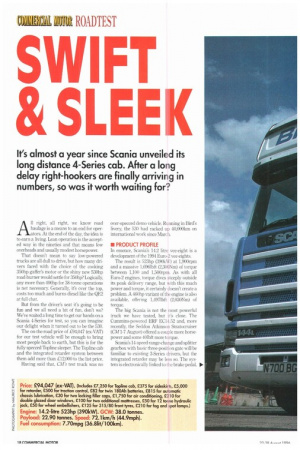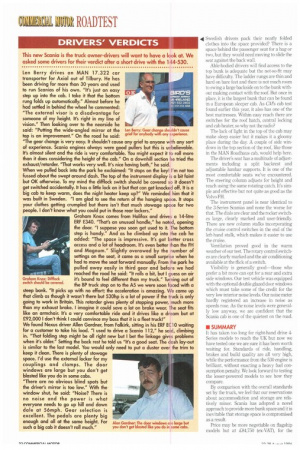It's almost a year since Scania unveiled its long distance
Page 20

Page 22

Page 24

Page 25

If you've noticed an error in this article please click here to report it so we can fix it.
4-Series cab. After a long delay right-hookers are finally arriving in numbers, so was it worth waiting for';'
All right, all right, we know road haulage is a means to an end for operators. At the end of the day, the idea is to earn a living. Lean operation is the accepted way in the nineties and that means low overheads and usually modest horsepower.
That doesn't mean to say low-powered trucks are all dull to drive, but how many drivers faced with the choice of the cooking 350hp gaffer's motor or the shiny new 530hp road-burner would settle for 35014p? Logically, any more than 400hp for 38-tonne operations is not necessary. Generally, it's over the top, costs too much and burns diesel like the QE2 at full chat.
But from the driver's seat it's going to be fun and we all need a bit of fun, don't we? We've waited a long time to get our hands on a Scania 4-Series for test, so you can imagine our delight when it turned out to be the 530.
The on-the-road price of £94,047 (ex-VAT) for our test vehicle will be enough to bring most people back to earth, but this is for the fully specced Topline sleeper. The Topline cab and the integrated retarder system between them add more than £12,000 to the list price.
Having said that. Cli's rest truck was no over-specced demo vehicle. Running in Bird's livery, the 530 had racked up 40,000km on international work since March.
• PRODUCT PROFILE In essence, Scania's 14.2 litre vee-eight is a development of the 1994 Euro-2 vee-eights.
The result is 523hp (390kW) at 1,900rpm and a massive 1,6961bft (2,300Nm) of torque between 1,1(X) and 1,500rpm. As with all Euro-2 engines, torque dives steeply outside its peak delivery range, but with this much power and torque. it certainly doesn't create a problem. A 460hp variant of the engine is also available, offering 1,4971bft (2,030Nni) of torque.
The big Scania is not the most powerful truck we have tested, but it's close. The Cummins-powered ERE' EC14.52 and, more recently, the Seddon Atkinson Stratocruiser (CM 1-7 August) offered a couple more horsepower and some 401bft more torque.
Scania's 14-speed range-change and splitter gearbox with basic three-position gate will he familiar to existing 3-Series drivers, but the integrated retarder may be less so. The system is electronically linked to the brake pedal, 11. dashboard control stalk and exhaust brake, offering manual or automatic operation. In manual mode, using the control stalk will progressively step-up the retarder and eventually bring in the exhaust brake. Otherwise, the maximum speed can be set either by touching the brake pedal or the microswitch at the end of the control stalk. The system will then automatically apply the retarder and exhaust brake to keep the vehicle at the selected speed.
Our test vehicle was fitted with the standard final drive ratio of 3.081 three alternatives offer lower overall gearing.
The all-steel Topline cab comes lavishly equipped. Air deflectors, electrically controlled roof hatch, central locking, heated air suspended driver and passenger seats and air conditioning are all part of the standard equipment.
• PRODUCTIVITY Developing as much power and torque as the big Scania is bound to carry a fuel consumption penalty. Under these circumstances, we reckon that 7.70mpg (36.8 lit/100km) overall around our Scottish Route is a very good result. To illustrate this, our recent Volvo FI..10 360 test produced a very similar figure.
Among our high power rivals, this puts the Scania above average for its class. It's not quite a match for the exceptional ERF EC14.52's 7.93mpg (35.61it/100km), but it shows that high power does not necessarily carry a heavy fuel penalty. The Scania was naturally at its best on motorways and dual carriageways, as our Tough Motorways and Easy A-roads figures show, using less fuel than the F,RF on both sections. It also topped our listed rivals on the A68 Severe Gradients section.
We certainly expected good average speeds from the Scania and we weren't disappointed here. Only the Seddon Atkinson Stratocruiser has completed the route significantly quicker.
No doubt the retarder contributed to the high average speed, offering swift downhill speeds without using the service brakes in most cases.
A big steel cab wasn't likely to do the Scania's weight many favours. Neither would two large fuel tanks. capable of carrying over a tonne of fuel. Our 144 tipped the scales at 8,1 tonnes, the same weight as the Seddon Atkinson Stratocruiser. The load could be reduced with alloy wheels, smaller fuel tanks and without a retarder, but it's still no lightweight.
• ON THE ROAD Testing at MIRA soon showed what we were in for. The Scania is probably the quickest truck from 32-64kin/h and 48-80km/h that we have tested. On the road, that translates into swift overtaking potential.
It also gave us some very rapid hill climbing. On the severe gradients where journeys to the bottom of the gearbox are usually frequent, the Sauna only dropped into low range on Black Hill. Where we normally expect to take whole gears or even block changes down on the steepest slopes, we took splits each time in the Scania.
On the motorway sections, the Scania rarely shifted out of top gear. Apart from the quick progress, it must also reduce wear and tear on the transmission and the driver.
The retarder's contribution in safety terms is invaluable. Even on the steepest slopes over our Severe Gradients section, we needed only occasional check braking to bring down the vehicle's speed. Otherwise on motorway descents and two other long descents; one in the Scottish borders and the other over Carter Bar, the retarder and exhaust brake controlled down-hill speed without additional braking.
High power is of little use if the ride and handling are not up to scratch. The Scania cab does roll but not to an unacceptable degree. Otherwise, the ride is very good, although we preferred to lock the seat suspension over poor surfaces. We expect well-balanced steering from a Scania and the 4-Series is like its 3Series predecessor here, we're pleased to say.
• CAB COMFORT We are still not entirely convinced by the storage and accommodation offered by the Topline cab. The four fold-down overhead lockers offer reasonable room but do even
44 Swedish drivers pack their neatly folded clothes into the space provided? There is a space behind the passenger seat for a bag or two, but they would need moving to slide the seat against the back wall.
Able-bodied drivers will find access to the top bunk is adequate but the not-so-fit may have difficulty, The ladder rungs are thin and hard on bare feet and there is not much room to swing a large backside on to the bunk without making contact with the roof. But once in place, it is the largest bunk that can be found in a European sleeper cab. As ars cab test found earlier this year, it also has one of the best mattresses. Within easy reach there are switches for the roof hatch, central locking and tab heater. so why not the radio?
The lack of light in the top of the cab may make sleep easier but it makes it a gloomy place during the day. A couple of side windows in the top section of the roof, like those in the MAN Roadhaus cab, would help here.
The driver's seat has a multitude of adjustments including a split backrest and adjustable lumbar supports. It is one of the most comfortable seats we've encountered. The steering column adjusts for height and reach using the same rotating catch. It's simple and effective but not quite as good as the Volvo FH.
The instrument panel is near identical to the 3-Series Scanias and none the worse for that. The dials are clear and the rocker switches large, clearly marked and user-friendly. There are new column stalks incorporating the cruise control switches in the end of the left-hand stalk, which makes it easier to use the cruise.
Ventilation proved good in the warm weather of our test. The rotary control switches are clearly marked and the air conditioning available at the flick of a switch.
Visibility is generally good—those who prefer a bit more can opt for a rear and extra side windows. Our test vehicle was equipped with the optional double glazed door windows which must take some of the credit for the very low interior noise levels. Our noise meter hardly registered an increase in noise as speeds rose. As the noise levels were generally low anyway, we are confident that the Scania cab is one of the quietest on the road.
• SUMMARY It has taken too long for right-hand drive 4Series models to reach the 1.11( but now we have tested one we are sure it has been worth waiting for. Standards of ride, handling, brakes and build quality are all very high, while the performance from the 530 engine is brilliant, without exacting a heavy fuel consumption penalty We look forward to testing the lesser-powered models to see how they compare.
By comparison with the overall standards set by the truck, we feel that our reservations about accommodation and storage are relatively minor. Scania has adopted a novel approach to provide more bunk space and it is inevitable that storage space is compromised as a result.
Price may be more negotiable on flagship models but at 184,750 (ex-VAT), for the "basic" 530 package including Topline cab, the Scania is not vastly more expensive than the ERF EC14.52 or MAN 18.463. There are other big cab rivals too, notably Leyland Daf's 95 Super Space Cab (over £93,000 for Euro-2), Volvo's FH16 Globetrotter XL (from around £75,000 in similar spec), the Renault Magnum 520 (£105,830) and the newest Foden's 4000 XL (from around £78,000). Yet to come is the Mercedes Actros, whose price won't be knowil for another few weeks at least.
All in all, the Scania R144 530 offers staggering performance and an excellent driving package. That will be enough to put it at the top of some driver's shopping lists. Given its good fuel consumption for so much power and legendary durability, it may even turn some operators' heads too.
by John Kendall




































































































